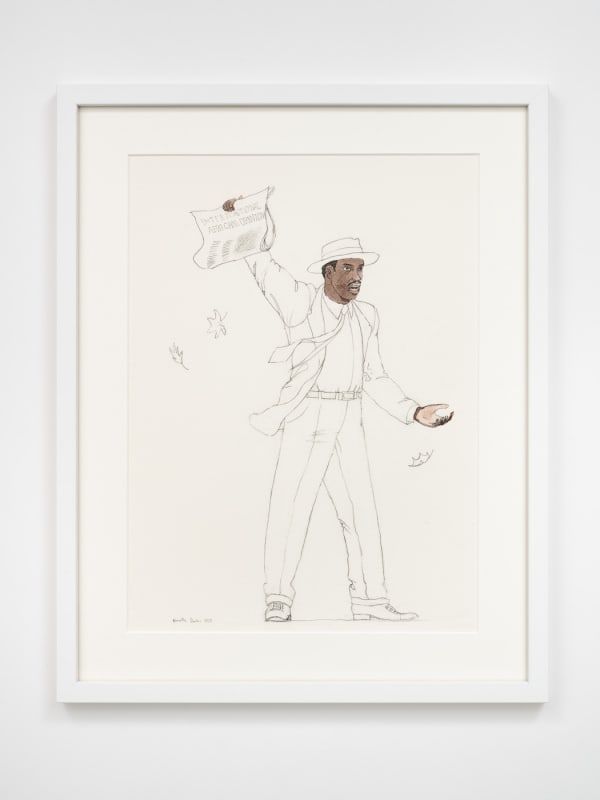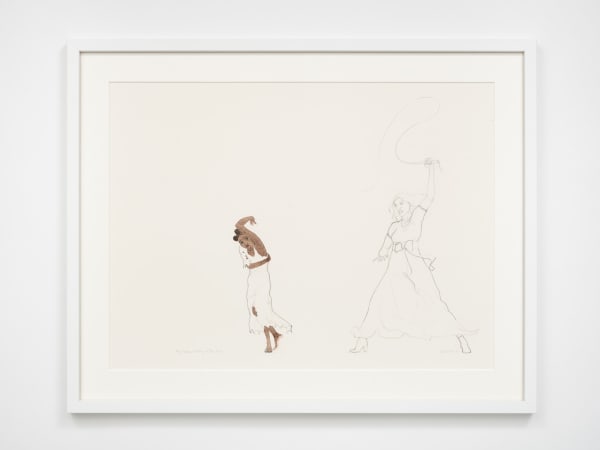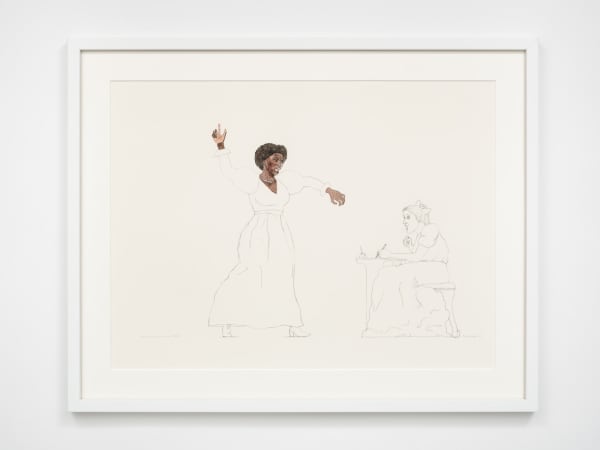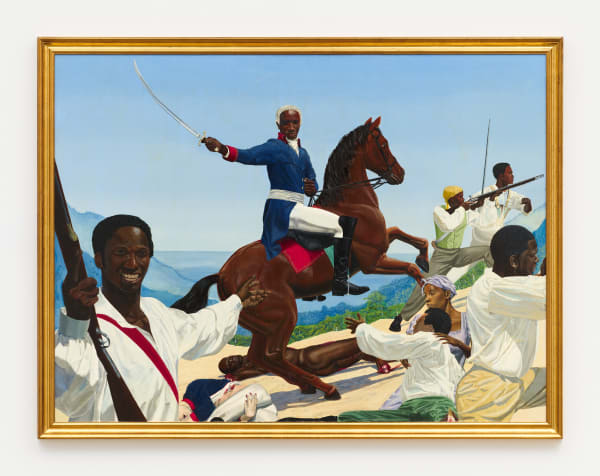Over the past twenty-five years Kimathi Donkor (b.Bournemouth, UK, 1965) has been making work that re-imagines mythic, legendary and domestic encounters across Africa and its global diasporas. Based in London, Donkor has been consistently been making work that can now be seen as pre-figuring debates and thinking about decolonising art history. Much of Donkor's work addresses both the way western canonical art has erased black subjectivity as well as its links to colonialism and the history of European empires. His work can be read as always being in dialogue with, and questioning of, canonical art history.
Donkor went to art school at Goldsmith's College, London, where is graduated from in 1987. During his time there he had become increasingly involved in a number of community initiatives in Brixton, the main site of the uprisings by the Black British community against state and police injustices in the 1980s. On leaving Goldsmith's, Donkor decided it would be more valuable contributing to those community initiatives rather than pursuing the more conventional career of an artist, and worked designing and contributing to a number of periodicals that were associated with community groups such as Black History for Action that was founded in 1986. He also exhibited with groups such as Creation for Liberation but in the 1990s largely took a break from making art, focusing instead on social activism.
Donkor returned to making art at the start of the 2000s. His experience of
working in the community fed into works that he made that focused on police brutality against members of the Black British community such as Cynthia Jarrett and Cherry Groce. Donkor also developed a number of paintings that retrieved black historical figures such as Toussaint L'Ouverture, the Nanny of the Maroons and Harriet Tubman. Donkor became aware of these figures whilst studying in part because of his own family connections to Jamaican, Nigeria and Ghana. It also struck him that the British education system at the time refused (and arguably still refuses) to give these figures their historical dues, or talk about the roles of colonialism, slavery, oppression and empire that is central to British history. The that Donkor started making from the start of the 2000s can all be understood as being in dialogue with history and art history. There is a very deliberate engagement with the styles of western canonical paintings, in order to re-insert the erased black figure and enable black subjectivity. These works then, can be seen as actively differencing the art historical canon, in some sense carrying that sense of activism over into decolonising art history.
In 2004 Donkor made a series of paintings titled 'Caribbean Passion: Haiti 1804' to mark the bicentary of Haiti's independence after the successful uprising by liberated slaves against French colonial rule in what then was Saint-Dominique (now Haiti). The series included the two paintings 'Toussaint L'Ouverture At Bedourete' (2004) and 'Bacchus & Ariadne' (2004) which the gallery will present at Independent. 'Toussaint L'Ouverture At Bedourete' draws on C.L.R.James's description of the L'Ouverture's defiance in the face of the French army. It also has a very deliberate dialogic relation to Jacques Louis David's celebrated 1801 painting 'Napoleon Crossing the Alps'. David's painting celebrated Napolean's 1797 invasion of Italy, presenting a triumphant vision of Napolean crossing the moutains separating France and Italy on his horse. At the same time of that invasion however, Toussaint L'Ouverture was leading freed slaves against French forces in Saint-Dominique, an event given far-less prominence in western history than Napolean's invasion over the Alps. Donkor's painting re-asserts this erased part of history. In Donkor's painting the figure of L'Ouverture might be understood of facing off or ready to combat David's Napolean. For whilst there is a clear visual echo of David's painting, L'Ouverture and his horse are postioned facing out towards the right of the canvas (as the viewer looks at it), mirroring the pose of Napolean and his horse in David's painting, who face left. If the paintings were hung side-by-sde with Donkor's on the left, LOuverture and Napolean would be facing each other, ready for battle.
In 'Bacchus & Ariadne' Donkor aimed to provide a pictorial response to the orders given by the French General Charles Le Clerk, Napolean's brother-in-law and in charge of suppressing the uprising. Le Clerk declared: "We must destroy all the mountain negrose, sparing only children under twelve years of age....I shall have to wage a war of extermination." In this painting, Donkor draws on Titian's 1523 painting 'Bacchus And Ariadne' but in a more indirect way than to the relationship between 'Toussaint L'Ouverture At Bedourete' and David's' Napolean Crossing the Alps'. Again Donkor's painting inverts the composition of the earlier painting so that his painting might be understood as answering back or facing off the earlier work, re-asserting the presence of an erased history to one that is well-known and taught in western classics. In Titian's work the chaos of Bacchus and his followers which although initially alarming to Ariadne, who looks startled on the left the painting, is ultimately well-meaning. However in Donkor's painting, the chaos brought by the French army is linked to their orders to wipe out the Haitians. There is no promise of safety for the figure on the right of Donkor's painting. This is a history painting that stops at the moment before the erasure of its subjects, insisting instead on bringing their presence back.
Donkor's strategy of appropriating western canonical art and re-inserting black historical figures into narratives they have been erased from is one that the artist used in many of his works from this period. For example, in 'Nanny of the Maroon's Fifth Act of Mercy' (2012), Donkor takes the composition from Joshua Reynolds's painting, 'Jane Fleming, later Countess of Harrington' (1778), a portrait of a British aristocrat whose family was involved in enslaving people in Jamaican plantations. The Nanny of the Maroons lead a community of formerly enslaved Africans who fought a guerilla war against the British authorities in Jamaica, and the painting might be read as usurping the colonial order.
In recent times, the idea of decolonising art history has become a more important and widely-discussed set of ideas. In particular this involves thinking about and dismantling the ways in which the canon of art history and silenced or erased the art histories and visual cultures of non-western people as well as foregrounding the extent towards the subject matters and genres of canonical art history have been entwined with the history and legacy of colonialism. This ranges from the relationship of landscape painting to the riches and plunder provided by empire through to the way primitivism was entwined with regressive views of the non-west. Donkor's works from this period embody a number of the ideas articulated by the ongoing project of decolonising art history and his importance to this ongoing project has been recently recognised with an increased presence in museums and institutions, such as the 57th Venice Biennale, Institute for Contemporary Arts (London, UK), Kettle's Yard (Cambridge, UK) and Sharjah Biennial 2023 (Sharjah, UAE).





